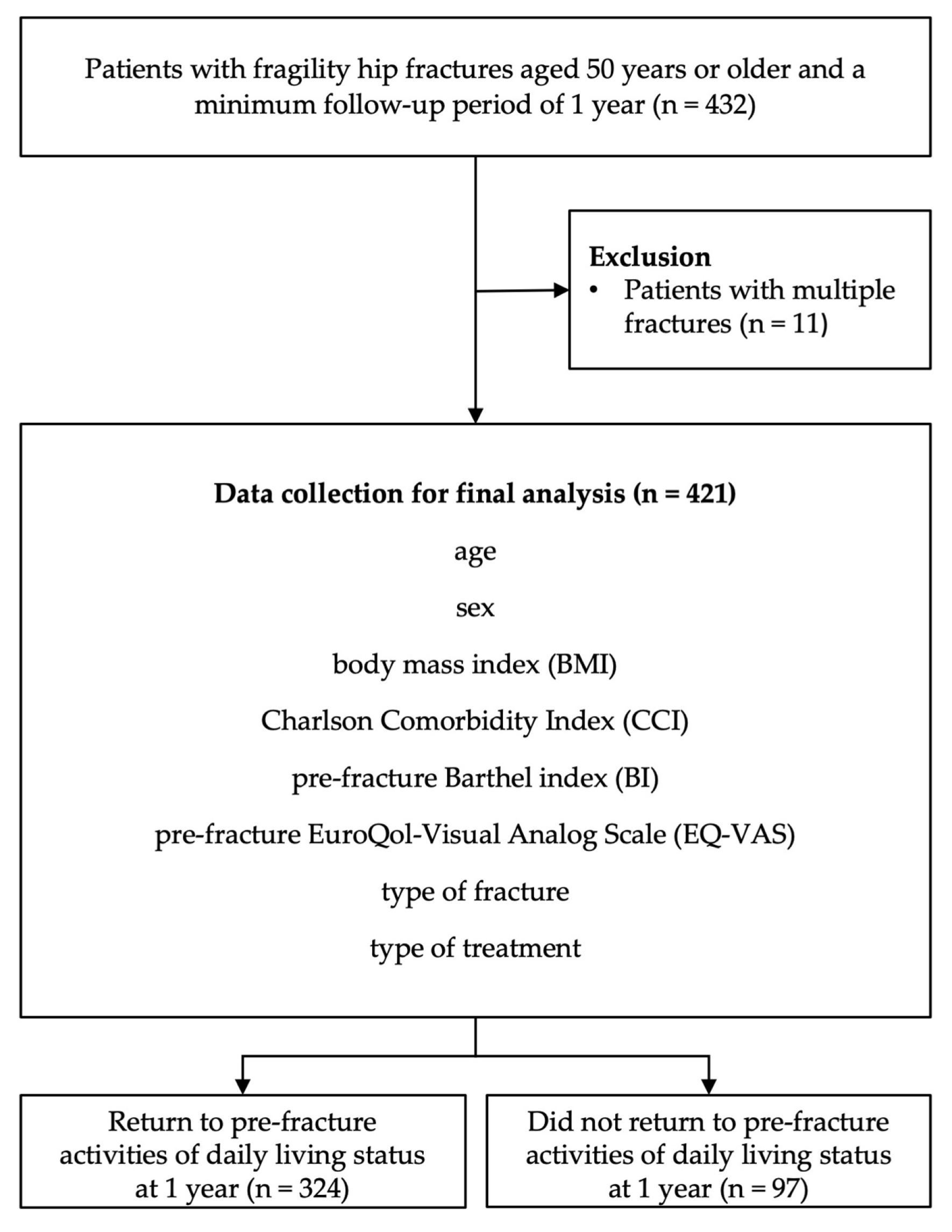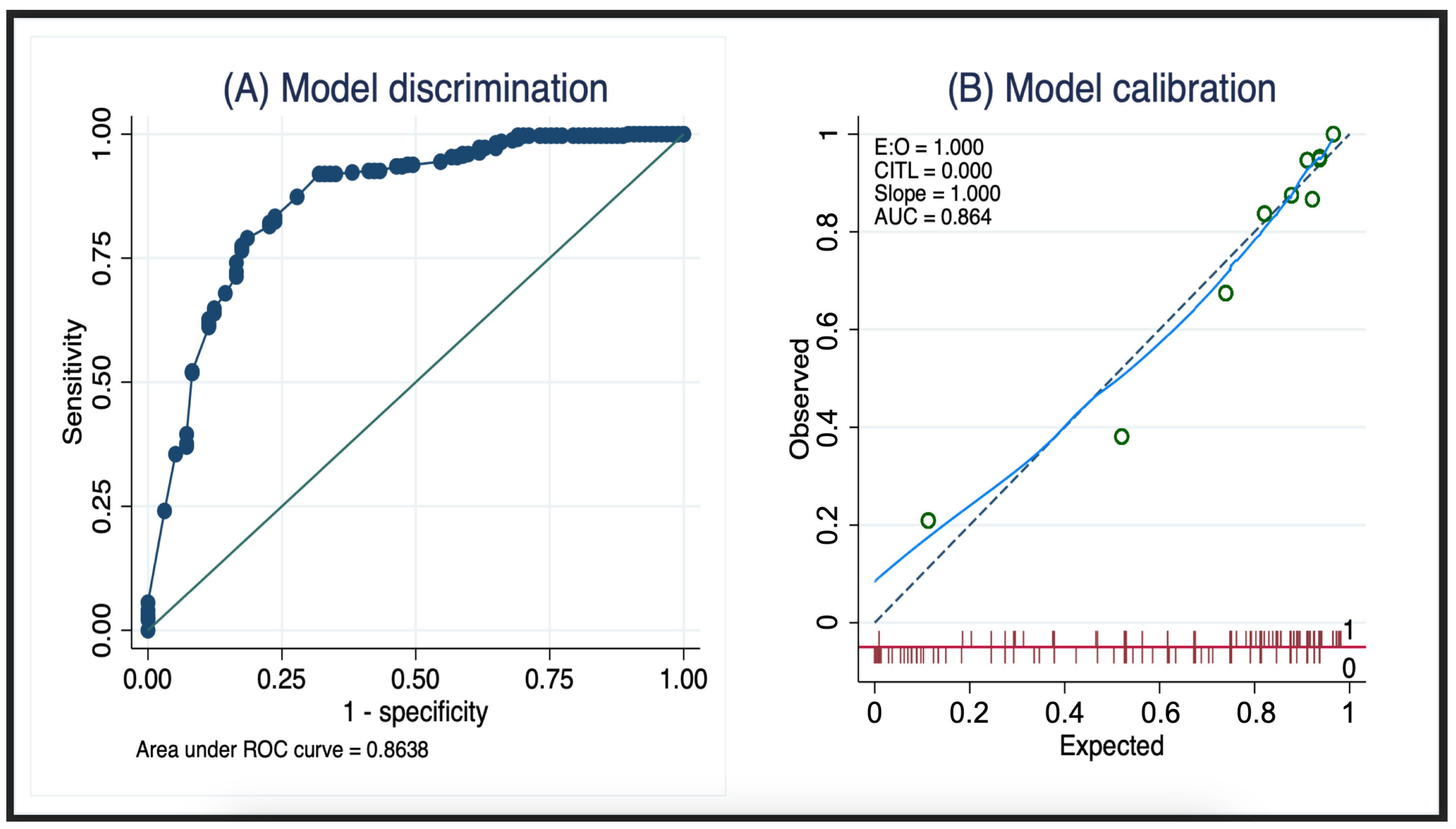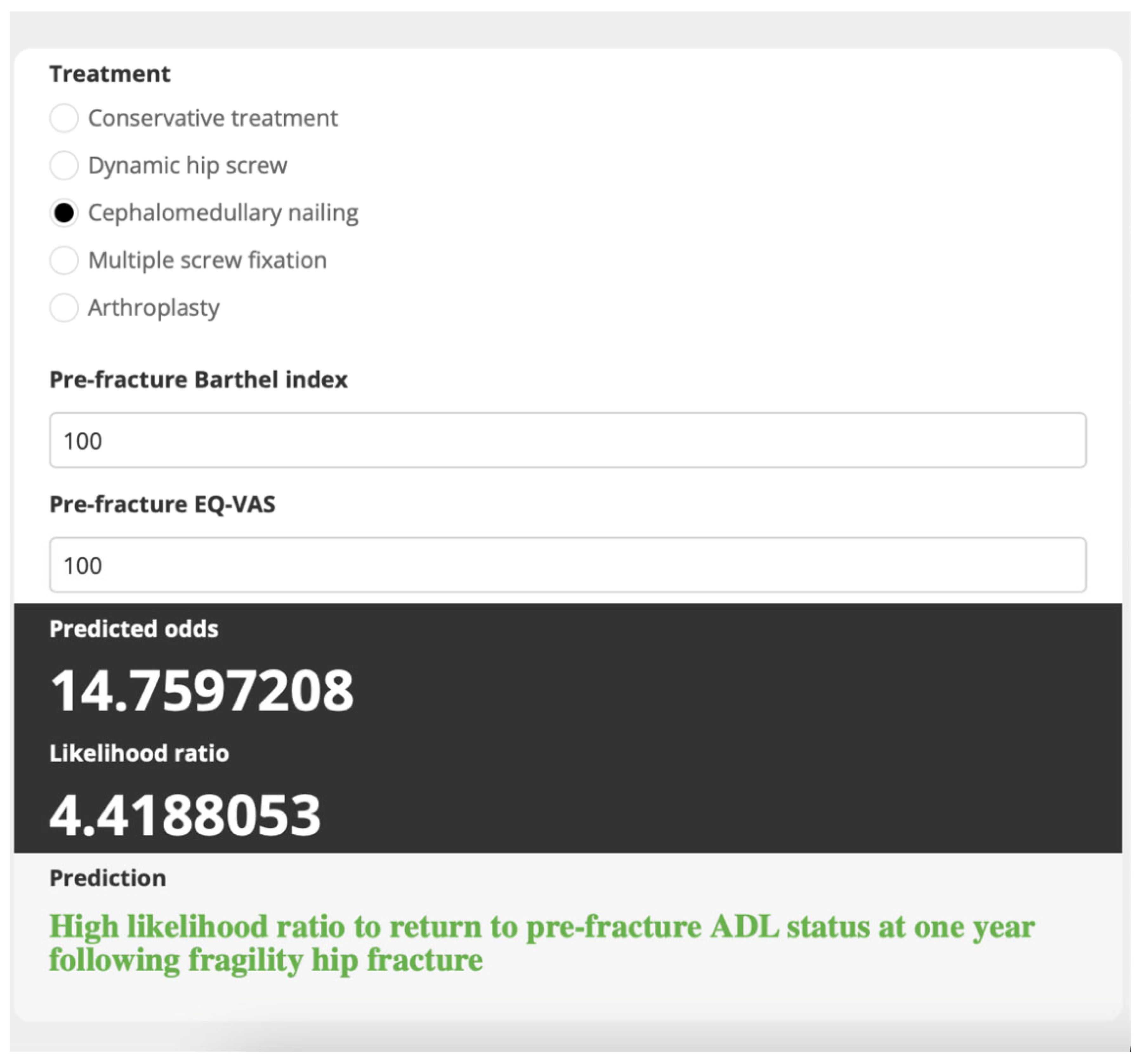Predictive Model of Recovery to Prefracture Activities-of-Daily-Living Status One Year after Fragility Hip Fracture
Abstract
1. Introduction
2. Materials and Methods
2.1. Design and Setting
2.2. Study Patients
2.3. Treatment Protocol
2.4. Data Collection
2.5. Statistical Analysis
3. Results
- Scenario 1:
- Scenario 2:
4. Discussion
5. Conclusions
Author Contributions
Funding
Institutional Review Board Statement
Informed Consent Statement
Data Availability Statement
Acknowledgments
Conflicts of Interest
References
- Kanis, J.A.; McCloskey, E.V.; Johansson, H.; Cooper, C.; Rizzoli, R.; Reginster, J.Y. European guidance for the diagnosis and management of osteoporosis in postmenopausal women. Osteoporos. Int. 2013, 24, 23–57. [Google Scholar] [CrossRef] [PubMed]
- Chapurlat, R.D.; Bauer, D.C.; Nevitt, M.; Stone, K.; Cummings, S.R. Incidence and risk factors for a second hip fracture in elderly women. The Study of Osteoporotic Fractures. Osteoporos. Int. 2003, 14, 130–136. [Google Scholar] [CrossRef] [PubMed]
- Center, J.R.; Nguyen, T.V.; Schneider, D.; Sambrook, P.N.; Eisman, J.A. Mortality after all major types of osteoporotic fracture in men and women: An observational study. Lancet 1999, 353, 878–882. [Google Scholar] [CrossRef] [PubMed]
- Peek-Asa, C.; Zwerling, C. Role of environmental interventions in injury control and prevention. Epidemiol. Rev. 2003, 25, 77–89. [Google Scholar] [CrossRef] [PubMed]
- Vaseenon, T.; Luevitoonvechkij, S.; Wongtriratanachai, P.; Rojanasthien, S. Long-term mortality after osteoporotic hip fracture in Chiang Mai, Thailand. J. Clin. Densitom. 2010, 13, 63–67. [Google Scholar] [CrossRef] [PubMed]
- Vochteloo, A.J.; Moerman, S.; Tuinebreijer, W.E.; Maier, A.B.; de Vries, M.R.; Bloem, R.M.; Nelissen, R.G.; Pilot, P. More than half of hip fracture patients do not regain mobility in the first postoperative year. Geriatr. Gerontol. Int. 2013, 13, 334–341. [Google Scholar] [CrossRef] [PubMed]
- Colón-Emeric, C.; Kuchibhatla, M.; Pieper, C.; Hawkes, W.; Fredman, L.; Magaziner, J.; Zimmerman, S.; Lyles, K.W. The contribution of hip fracture to risk of subsequent fractures: Data from two longitudinal studies. Osteoporos. Int. 2003, 14, 879–883. [Google Scholar] [CrossRef] [PubMed]
- Aubrun, F. Hip fracture surgery in the elderly patient: Epidemiological data and risk factors. Ann. Fr. Anesth. Reanim. 2011, 30, e37–e39. [Google Scholar] [CrossRef]
- Gullberg, B.; Johnell, O.; Kanis, J.A. World-wide projections for hip fracture. Osteoporos. Int. 1997, 7, 407–413. [Google Scholar] [CrossRef]
- Wongtriratanachai, P.; Luevitoonvechkij, S.; Songpatanasilp, T.; Sribunditkul, S.; Leerapun, T.; Phadungkiat, S.; Rojanasthien, S. Increasing incidence of hip fracture in Chiang Mai, Thailand. J. Clin. Densitom. 2013, 16, 347–352. [Google Scholar] [CrossRef]
- Sukchokpanich, P.; Anusitviwat, C.; Jarusriwanna, A.; Kitcharanant, N.; Unnanuntana, A. Quality of Life and Depression Status of Caregivers of Patients with Femoral Neck or Intertrochanteric Femoral Fractures during the First Year after Fracture Treatment. Orthop. Surg. 2023, 15, 1854–1861. [Google Scholar] [CrossRef] [PubMed]
- Scaf-Klomp, W.; van Sonderen, E.; Sanderman, R.; Ormel, J.; Kempen, G.I. Recovery of physical function after limb injuries in independent older people living at home. Age Ageing 2001, 30, 213–219. [Google Scholar] [CrossRef] [PubMed]
- Magaziner, J.; Hawkes, W.; Hebel, J.R.; Zimmerman, S.I.; Fox, K.M.; Dolan, M.; Felsenthal, G.; Kenzora, J. Recovery from hip fracture in eight areas of function. J. Gerontol. A Biol. Sci. Med. Sci. 2000, 55, M498–M507. [Google Scholar] [CrossRef] [PubMed]
- Huusko, T.M.; Karppi, P.; Avikainen, V.; Kautiainen, H.; Sulkava, R. Intensive geriatric rehabilitation of hip fracture patients: A randomized, controlled trial. Acta Orthop. Scand. 2002, 73, 425–431. [Google Scholar] [CrossRef] [PubMed]
- Wawruch, M.; Krcmery, S.; Bozekova, L.; Wsolova, L.; Lassan, S.; Slobodova, Z.; Kriska, M. Factors influencing prognosis of pneumonia in elderly patients. Aging Clin. Exp. Res. 2004, 16, 467–471. [Google Scholar] [CrossRef] [PubMed]
- Mahaisavariya, C.; Vanitcharoenkul, E.; Kitcharanant, N.; Chotiyarnwong, P.; Unnanuntana, A. Exploring the osteoporosis treatment gap after fragility hip fracture at a Tertiary University Medical Center in Thailand. BMC Geriatr. 2023, 23, 70. [Google Scholar] [CrossRef] [PubMed]
- Sinoff, G.; Ore, L. The Barthel activities of daily living index: Self-reporting versus actual performance in the old-old (> or = 75 years). J. Am. Geriatr. Soc. 1997, 45, 832–836. [Google Scholar] [CrossRef]
- Unnanuntana, A.; Jarusriwanna, A.; Nepal, S. Validity and responsiveness of Barthel index for measuring functional recovery after hemiarthroplasty for femoral neck fracture. Arch. Orthop. Trauma Surg. 2018, 138, 1671–1677. [Google Scholar] [CrossRef] [PubMed]
- Della Pietra, G.L.; Savio, K.; Oddone, E.; Reggiani, M.; Monaco, F.; Leone, M.A. Validity and reliability of the Barthel index administered by telephone. Stroke 2011, 42, 2077–2079. [Google Scholar] [CrossRef]
- Kim, S.; Won, C.W.; Kim, B.S.; Kim, S.; Yoo, J.; Byun, S.; Jang, H.C.; Cho, B.L.; Son, S.J.; Lee, J.H.; et al. EuroQol Visual Analogue Scale (EQ-VAS) as a Predicting Tool for Frailty in Older Korean Adults: The Korean Frailty an Aging Cohort Study (KFACS). J. Nutr. Health Aging 2018, 22, 1275–1280. [Google Scholar] [CrossRef]
- Kitcharanant, N.; Atthakomol, P.; Khorana, J.; Phinyo, P.; Unnanuntana, A. Prognostic Factors for Functional Recovery at 1-Year Following Fragility Hip Fractures. Clin. Orthop. Surg. 2024, 16, 7–15. [Google Scholar] [CrossRef] [PubMed]
- Mathew, R.O.; Hsu, W.H.; Young, Y. Effect of comorbidity on functional recovery after hip fracture in the elderly. Am. J. Phys. Med. Rehabil. 2013, 92, 686–696. [Google Scholar] [CrossRef] [PubMed]
- Amarilla-Donoso, F.J.; Roncero-Martin, R.; Lavado-Garcia, J.M.; Toribio-Felipe, R.; Moran-Garcia, J.M.; Lopez-Espuela, F. Quality of life after hip fracture: A 12-month prospective study. PeerJ 2020, 8, e9215. [Google Scholar] [CrossRef] [PubMed]
- Shyu, Y.I.; Chen, M.C.; Liang, J.; Lu, J.F.; Wu, C.C.; Su, J.Y. Changes in quality of life among elderly patients with hip fracture in Taiwan. Osteoporos. Int. 2004, 15, 95–102. [Google Scholar] [CrossRef] [PubMed]
- Hsu, C.E.; Huang, K.C.; Lin, T.C.; Tong, K.M.; Lee, M.H.; Chiu, Y.C. Integrated risk scoring model for predicting dynamic hip screw treatment outcome of intertrochanteric fracture. Injury 2016, 47, 2501–2506. [Google Scholar] [CrossRef] [PubMed]
- Phruetthiphat, O.A.; Pinijprapa, P.; Satravaha, Y.; Kitcharanant, N.; Pongchaiyakul, C. An innovative scoring system for predicting an excellent Harris hip score after proximal femoral nail anti-rotation in elderly patients with intertrochanteric fracture. Sci. Rep. 2022, 12, 19939. [Google Scholar] [CrossRef] [PubMed]
- Tanaka, R.; Umehara, T.; Fujimura, T.; Ozawa, J. Clinical Prediction Rule for Declines in Activities of Daily Living at 6 Months After Surgery for Hip Fracture Repair. Arch. Phys. Med. Rehabil. 2016, 97, 2076–2084. [Google Scholar] [CrossRef] [PubMed]
- Sheehan, K.J.; Williamson, L.; Alexander, J.; Filliter, C.; Sobolev, B.; Guy, P.; Bearne, L.M.; Sackley, C. Prognostic factors of functional outcome after hip fracture surgery: A systematic review. Age Ageing 2018, 47, 661–670. [Google Scholar] [CrossRef] [PubMed]
- Lim, K.K.; Matchar, D.B.; Chong, J.L.; Yeo, W.; Howe, T.S.; Koh, J.S.B. Pre-discharge prognostic factors of physical function among older adults with hip fracture surgery: A systematic review. Osteoporos. Int. 2019, 30, 929–938. [Google Scholar] [CrossRef]
- Kim, J.L.; Jung, J.S.; Kim, S.J. Prediction of Ambulatory Status After Hip Fracture Surgery in Patients Over 60 Years Old. Ann. Rehabil. Med. 2016, 40, 666–674. [Google Scholar] [CrossRef]
- Malhotra, R.; Huq, S.S.; Chong, M.; Murphy, D.; Daruwalla, Z.J. Outcomes in Nonagenarians with Hip Fractures Treated Conservatively and Surgically. Malays. Orthop. J. 2021, 15, 21–28. [Google Scholar] [CrossRef] [PubMed]
- Mayoral, A.P.; Ibarz, E.; Gracia, L.; Mateo, J.; Herrera, A. The use of Barthel index for the assessment of the functional recovery after osteoporotic hip fracture: One year follow-up. PLoS ONE 2019, 14, e0212000. [Google Scholar] [CrossRef] [PubMed]
- Bliemel, C.; Sielski, R.; Doering, B.; Dodel, R.; Balzer-Geldsetzer, M.; Ruchholtz, S.; Buecking, B. Pre-fracture quality of life predicts 1-year survival in elderly patients with hip fracture-development of a new scoring system. Osteoporos. Int. 2016, 27, 1979–1987. [Google Scholar] [CrossRef] [PubMed]
- Trovarelli, G.; Crimì, A.; Mori, F.; De Martini, N.F.; Cerchiaro, M.C.; Ruggieri, P. Proximal femur fractures in elderly patients: Gender-related differences in survival and functional outcomes. J. Sex-Gend.-Specif. Med. 2023, 9, 69–75. [Google Scholar] [CrossRef]




| Patient Characteristics | Return to Prefracture Activities-of-Daily-Living Status (n = 324) | Did Not Return to Prefracture Activities-of-Daily-Living Status (n = 97) | Odds Ratio | 95% CI | p-Value | auROC |
|---|---|---|---|---|---|---|
| Age (y), mean ± SD | 77.33 ± 9.65 | 81.35 ± 8.39 | 0.95 | [0.93–0.98] | <0.001 | 0.61 [0.55–0.67] |
| Female sex, n (%) | 242 (74.69%) | 76 (78.35%) | 0.82 | [0.47–1.41] | 0.463 | 0.52 [0.47–0.57] |
| Body mass index (kg/m2), mean ± SD | 22.68 ± 4.11 | 22.12 ± 4.02 | 1.03 | [0.98–1.10] | 0.24 | 0.54 [0.47–0.60] |
| Charlson comorbidity index score, n (%) | ||||||
| –<5 | 178 (54.94%) | 31 (31.96%) | 2.6 | [1.61–4.19] | <0.001 | 0.61 [0.56–0.67] |
| Type of fracture, n (%) | ||||||
| –Femoral neck fracture | 178 (54.94%) | 46 (47.42%) | 1.35 | [0.86–2.13] | 0.19 | 0.54 [0.48–0.59] |
| Treatment, n (%) | ||||||
| –Conservative treatment | 3 (0.93%) | 14 (14.43%) | 0.60 [0.53–0.66] | |||
| –Dynamic hip screw | 21 (6.48%) | 6 (6.19%) | 16.33 | [3.49–76.35] | <0.001 | |
| –Cephalomedullary nailing | 133 (41.05%) | 40 (41.24%) | 15.52 | [4.25–56.71] | <0.001 | |
| –Multiple screw fixation | 14 (4.32%) | 2 (2.06%) | 32.67 | [4.71–226.52] | <0.001 | |
| –Arthroplasty | 153 (47.22%) | 35 (36.08%) | 20.4 | [5.56–74.85] | <0.001 | |
| Prefracture BI, mean ± SD | 96.7 ± 6.02 | 80.72 ± 17.79 | 1.16 | [1.12–1.20] | <0.001 | 0.83 [0.79–0.88] |
| Prefracture EQ-VAS, mean ± SD | 92.48 ± 7.75 | 79.18 ± 16.29 | 1.11 | [1.08–1.14] | <0.001 | 0.76 [0.70–0.82] |
| Predictors | Terms | df | Formula | Log Odds Ratio | 95% CI | p-Value |
|---|---|---|---|---|---|---|
| Intercept | 0.26 | −1.25, 1.76 | 0.739 | |||
| Age | Out | 0 | – | – | – | – |
| CCI | Out | 0 | – | – | – | – |
| Treatment | Linear | 1 | ||||
| –Dynamic hip screw | 2.14 | 0.29, 3.98 | 0.02 | |||
| –Cephalomedullary nailing | 2.06 | 0.53, 3.6 | 0.01 | |||
| –Multiple screw fixation | 3.3 | 0.48, 6.12 | 0.02 | |||
| –Arthroplasty | 2.08 | 0.54, 3.62 | 0.01 | |||
| Prefracture Barthel index | Linear | 1 | Prefracture Barthel index-100 | 0.12 | 0.08, 0.16 | <0.001 |
| Prefracture EQ-VAS | Linear | 1 | Prefracture EQ-VAS-90 | 0.04 | 0.001, 0.07 | 0.045 |
| Categories | LHR to Return to Prefracture Activties-of-Daily-Living Status | Return to Prefracture Activities-of-Daily-Living Status | Did Not Return to Prefracture Activities-of-Daily-Living Status | LR+ | 95% CI of LR+ | PPV | 95% CI of PPV | p-Value | ||
|---|---|---|---|---|---|---|---|---|---|---|
| n | % | n | % | |||||||
| Low | <1.3 | 68 | 21 | 79 | 81.4 | 0.26 | 0.20 0.32 | 46.3% | 38.0% 54.7% | <0.001 |
| High | ≥1.3 | 256 | 79 | 18 | 18.6 | 4.26 | 2.80 6.48 | 93.4% | 89.8% 96.1% | <0.001 |
Disclaimer/Publisher’s Note: The statements, opinions and data contained in all publications are solely those of the individual author(s) and contributor(s) and not of MDPI and/or the editor(s). MDPI and/or the editor(s) disclaim responsibility for any injury to people or property resulting from any ideas, methods, instructions or products referred to in the content. |
© 2024 by the authors. Licensee MDPI, Basel, Switzerland. This article is an open access article distributed under the terms and conditions of the Creative Commons Attribution (CC BY) license (https://creativecommons.org/licenses/by/4.0/).
Share and Cite
Kitcharanant, N.; Atthakomol, P.; Khorana, J.; Phinyo, P.; Unnanuntana, A. Predictive Model of Recovery to Prefracture Activities-of-Daily-Living Status One Year after Fragility Hip Fracture. Medicina 2024, 60, 615. https://doi.org/10.3390/medicina60040615
Kitcharanant N, Atthakomol P, Khorana J, Phinyo P, Unnanuntana A. Predictive Model of Recovery to Prefracture Activities-of-Daily-Living Status One Year after Fragility Hip Fracture. Medicina. 2024; 60(4):615. https://doi.org/10.3390/medicina60040615
Chicago/Turabian StyleKitcharanant, Nitchanant, Pichitchai Atthakomol, Jiraporn Khorana, Phichayut Phinyo, and Aasis Unnanuntana. 2024. "Predictive Model of Recovery to Prefracture Activities-of-Daily-Living Status One Year after Fragility Hip Fracture" Medicina 60, no. 4: 615. https://doi.org/10.3390/medicina60040615
APA StyleKitcharanant, N., Atthakomol, P., Khorana, J., Phinyo, P., & Unnanuntana, A. (2024). Predictive Model of Recovery to Prefracture Activities-of-Daily-Living Status One Year after Fragility Hip Fracture. Medicina, 60(4), 615. https://doi.org/10.3390/medicina60040615






